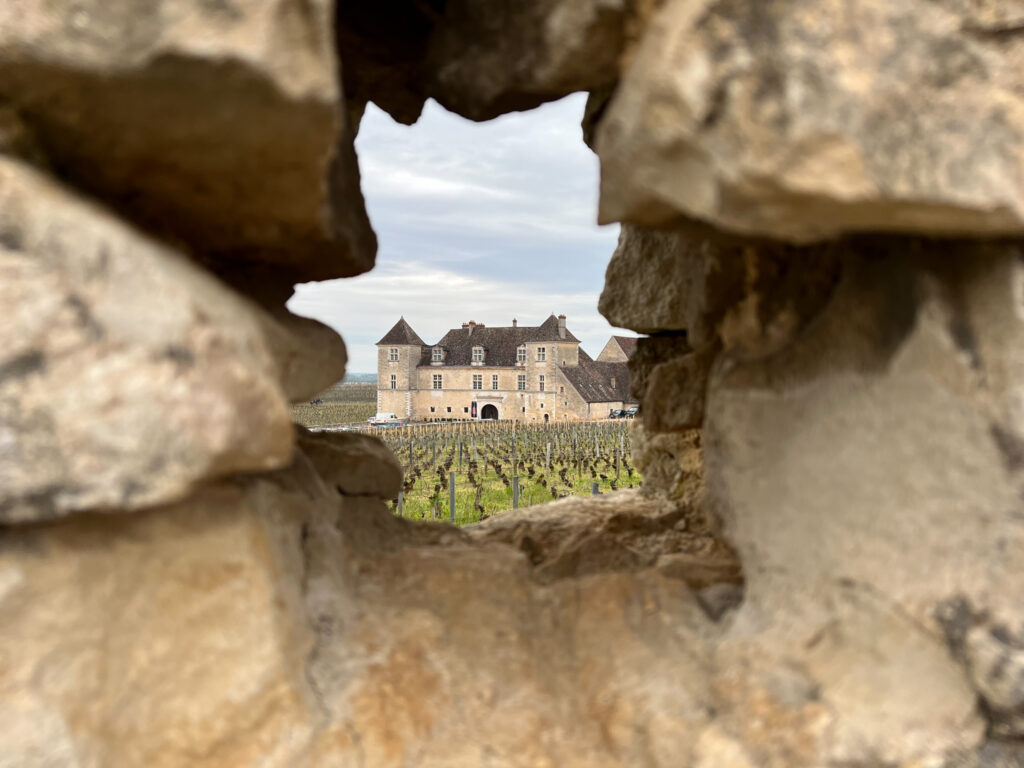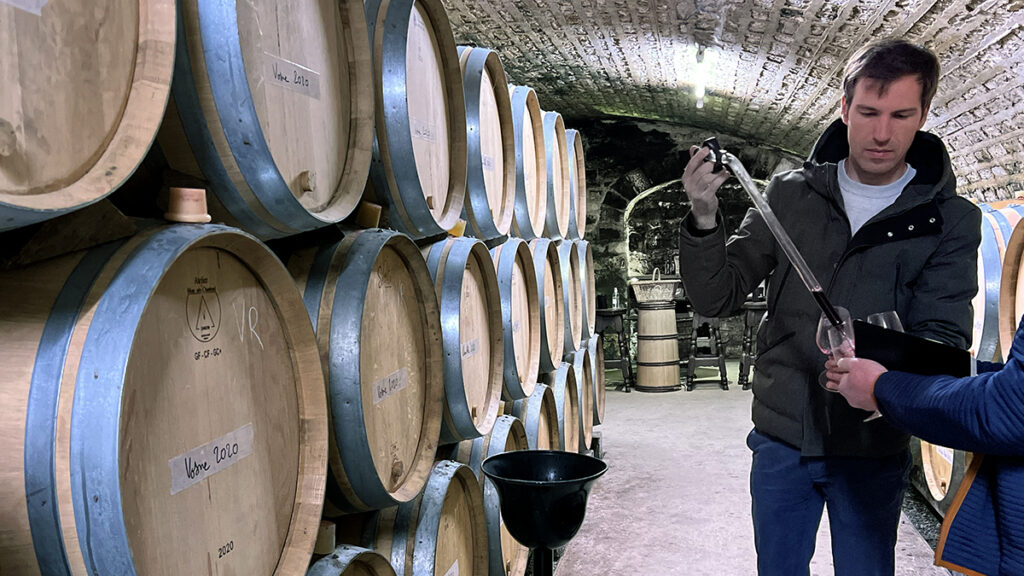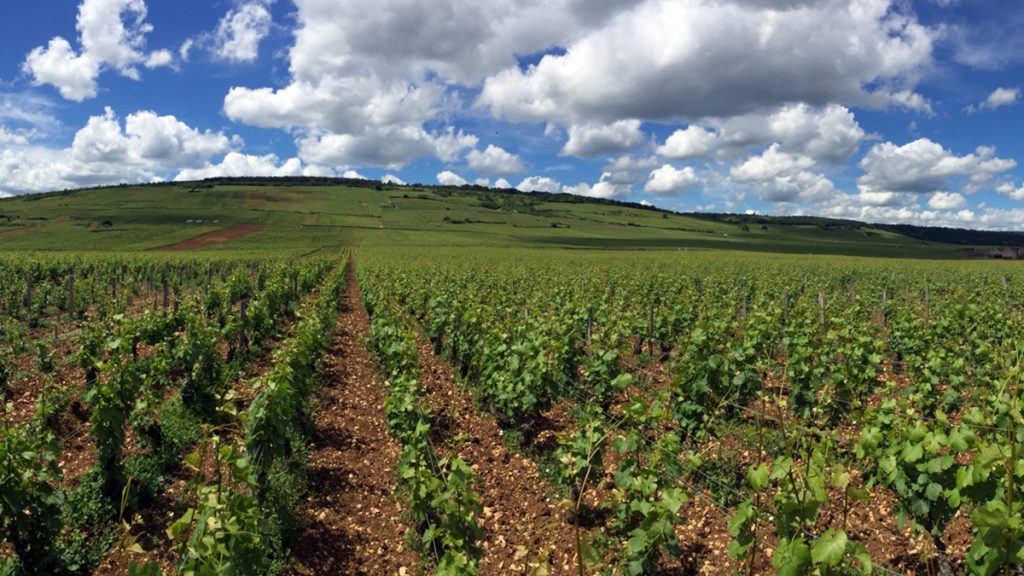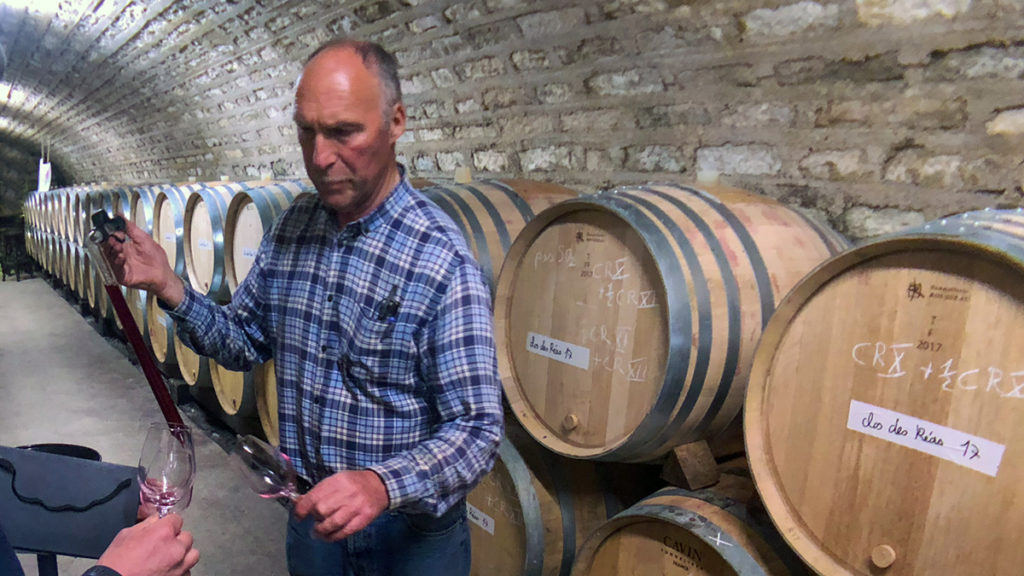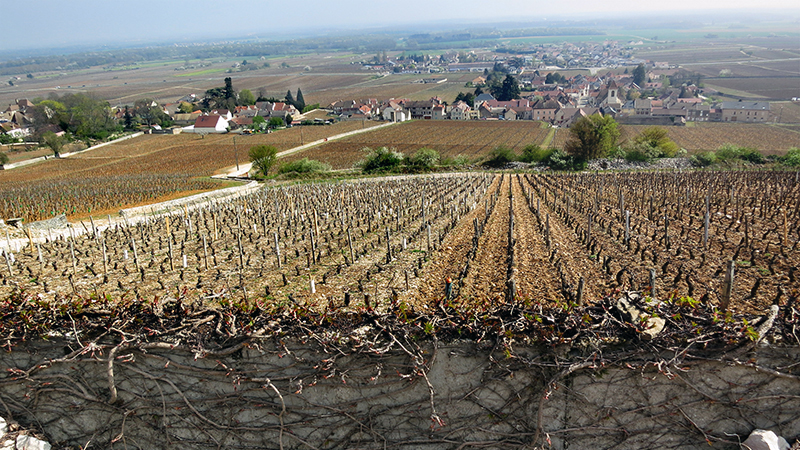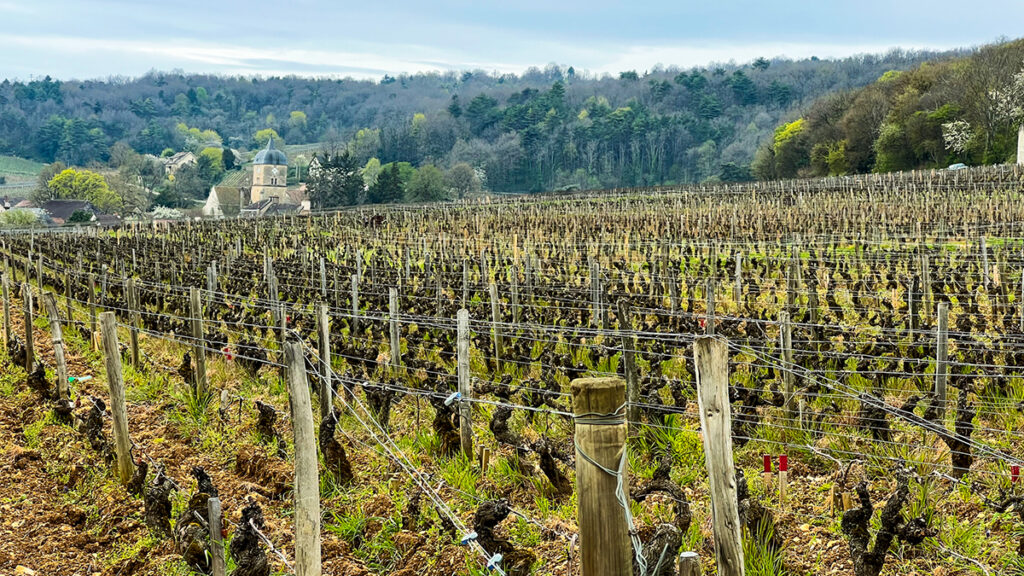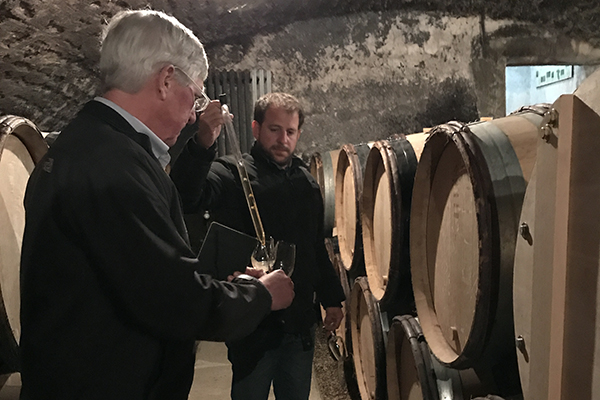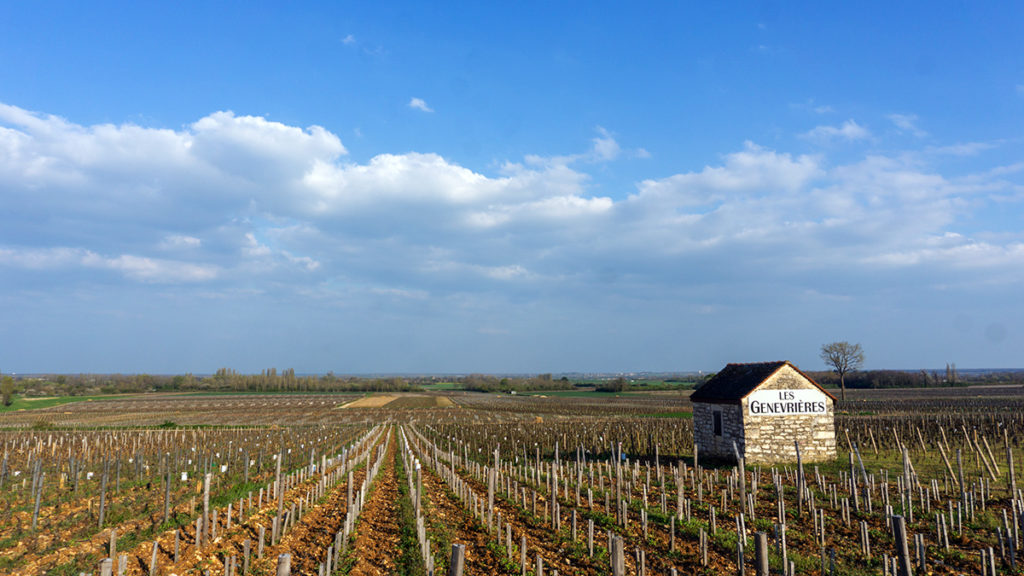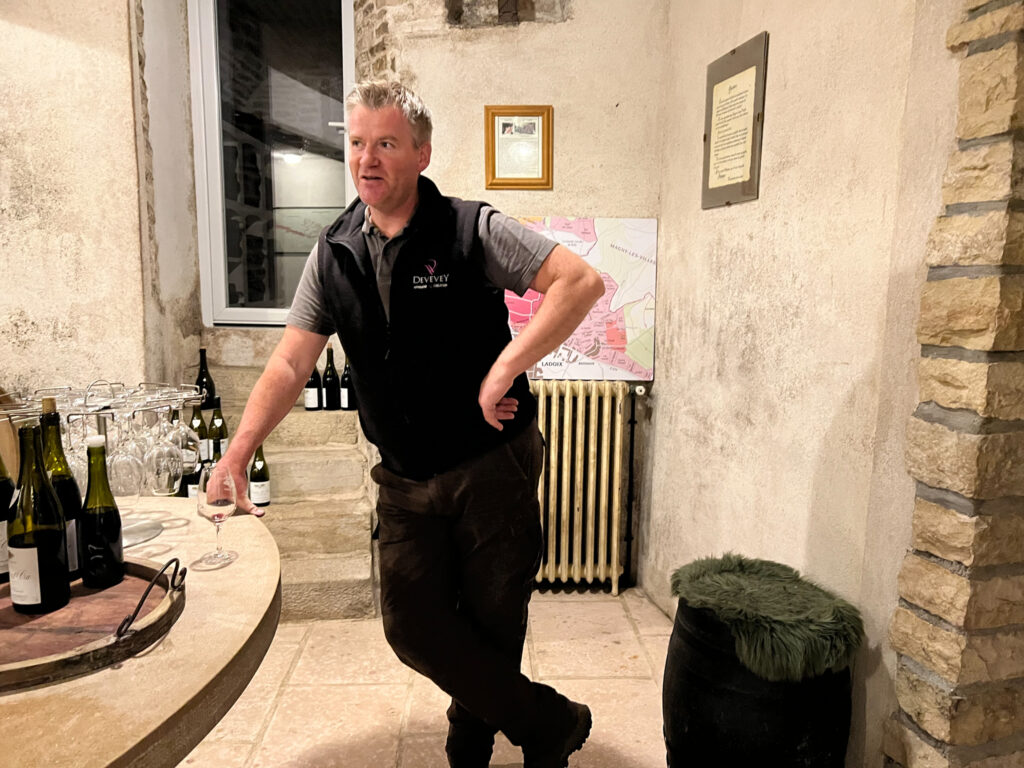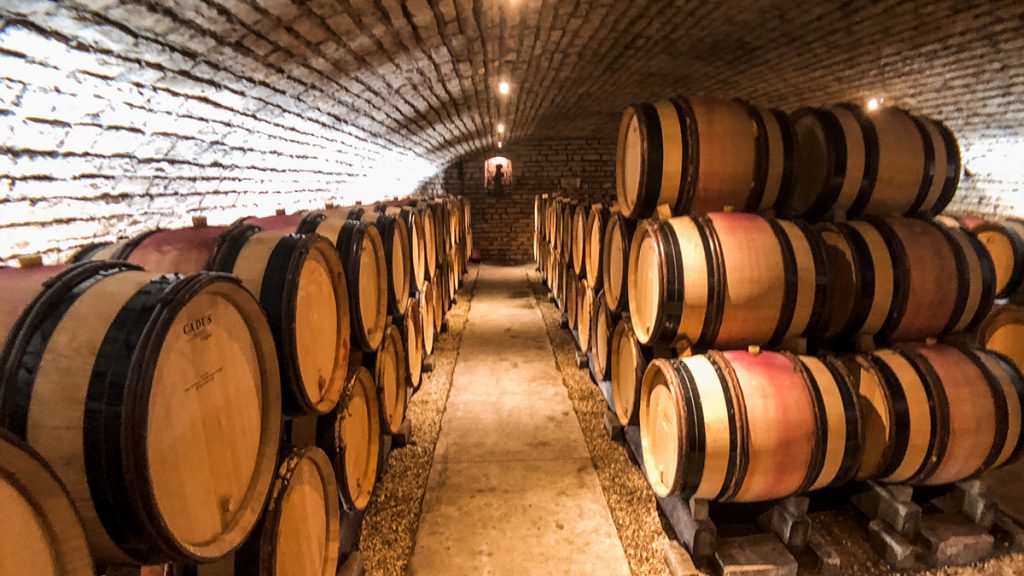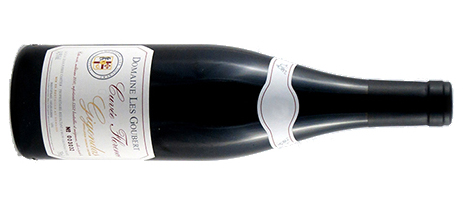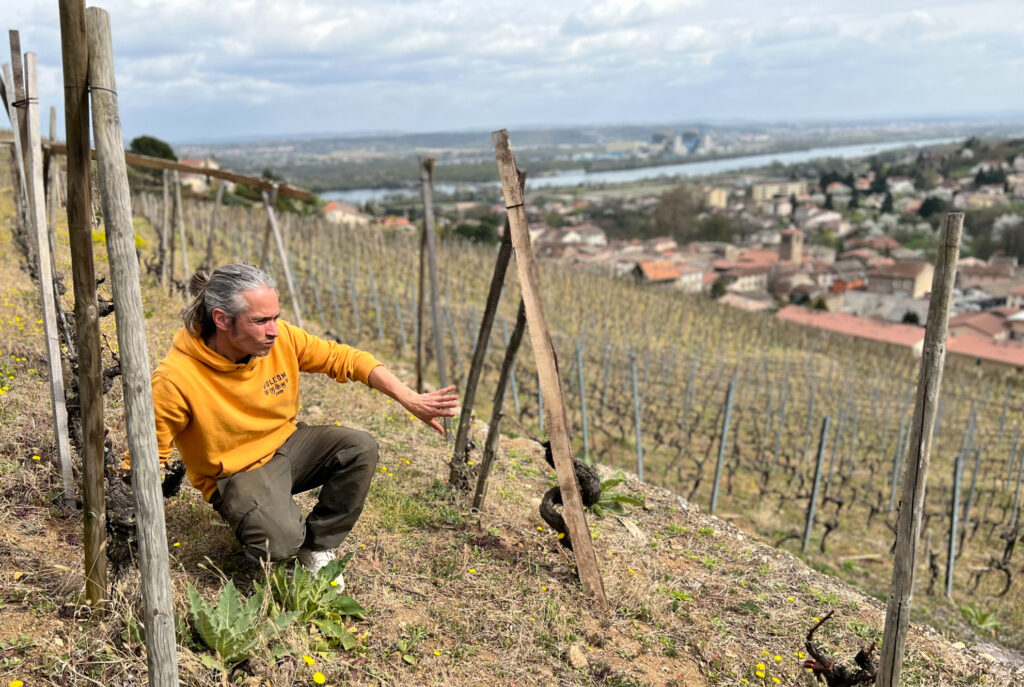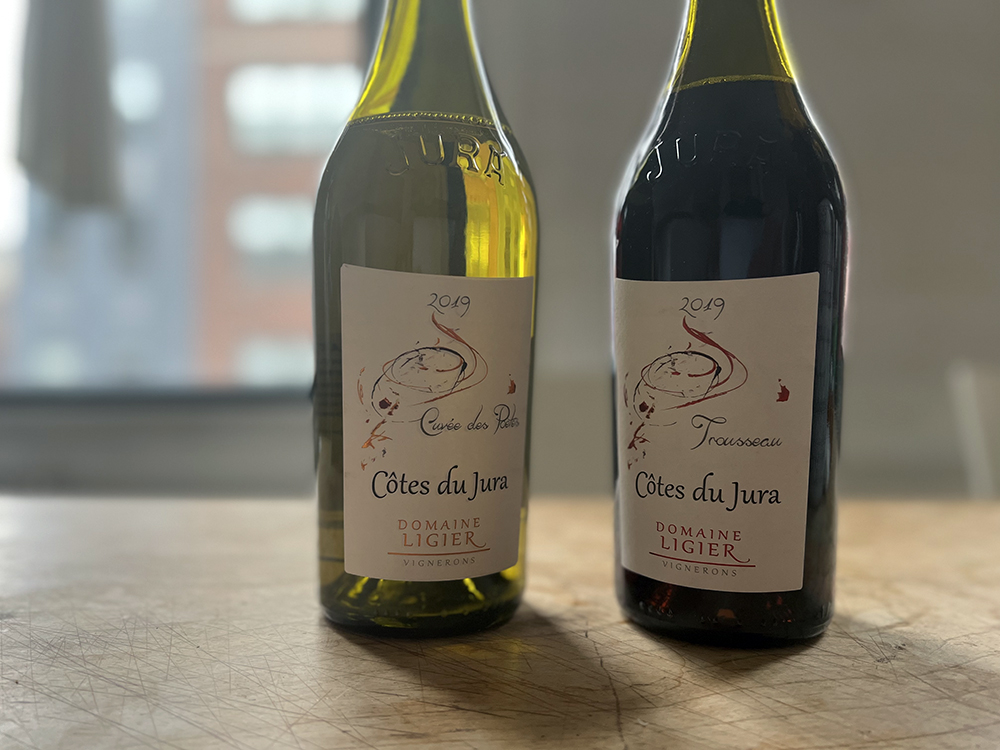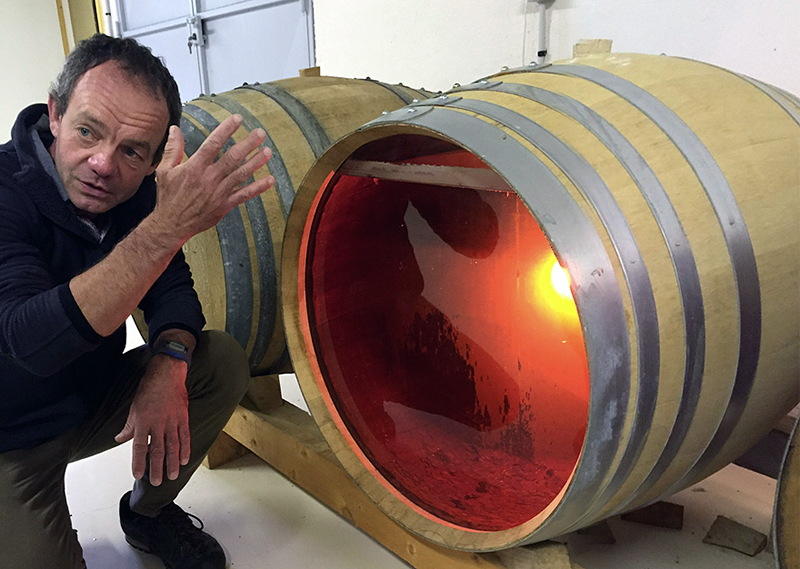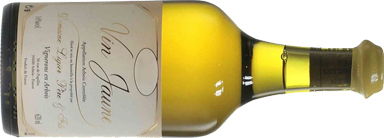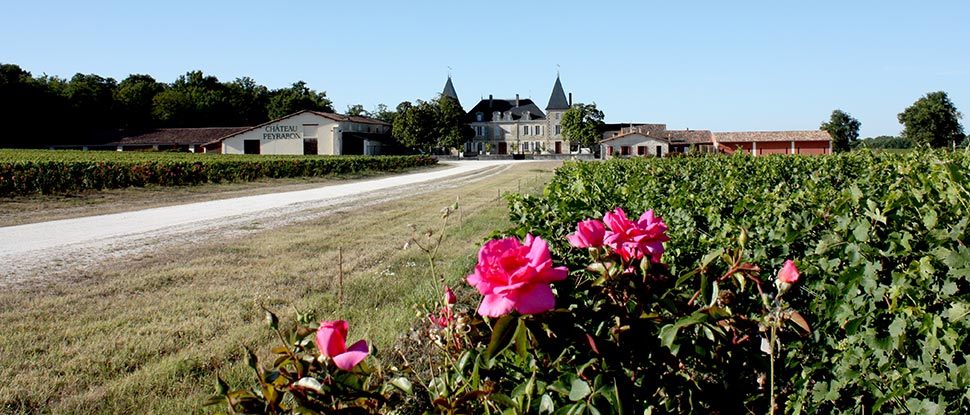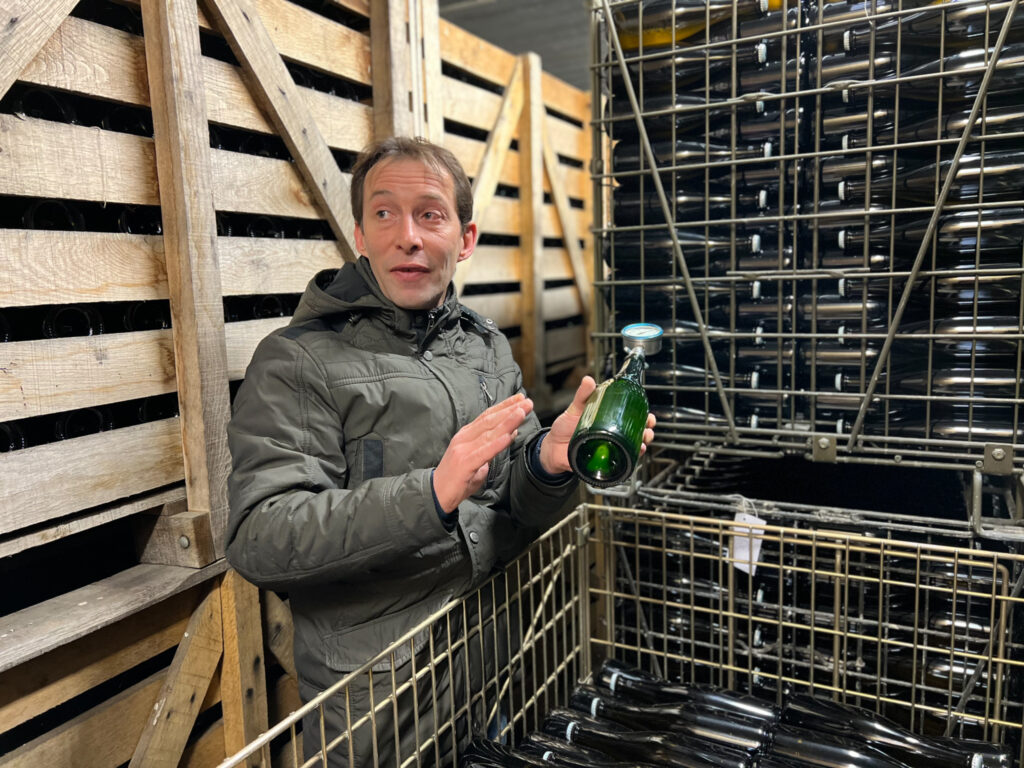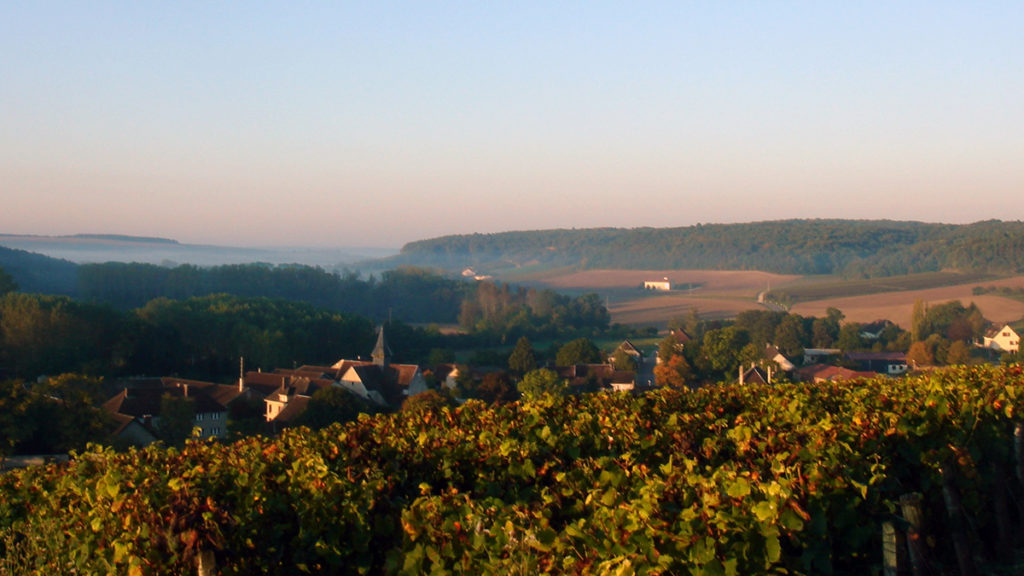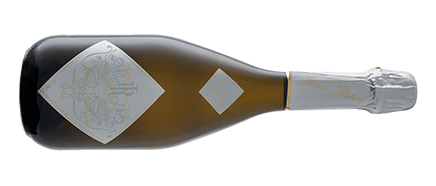October is a time for breathing out in the vineyards across France, as vignerons recover from the heightened pace and stress of the harvest. All the year’s work builds toward the vendanges, and the many decisions made then have a decisive impact on the success of the year’s vintage. Deciding when to harvest is complex and uncertain, as vignerons must schedule their picking while they track the varied ripening rates of the stems, skins, pips and flesh of their grapes, all the while guessing at weather conditions that are as unpredictable as, well, the weather. Important decisions continue throughout the harvest — where and when to harvest each day, whether to pre-soak, when to press, how hard to press, etc. And then quite suddenly, the die is cast for the vintage. The Wine Advocate’s William Kelley, who judges wine brilliantly, also writes perceptively about the rhythms of vineyard life in Burgundy (which he has made home). He describes a natural letdown each year after the burst of creative activity that caps the season’s work. After a 2021 that would have tested the patience of Job, 2022 brought a welcome dose of normalcy. What is more, this fall offers vignerons the continuing pleasure of selling the 2020 vintage. It continues a surprisingly common occurrence in Burgundy: after a great year comes another that more than holds its own (say 2010 following 2009, or 2016 following 2015). We think 2019 and 2020 are such a pair; and with the nearly empty barrel rooms of the 2021 vintage in mind, it’s hard to think of a better time than this fall to stock up on Burgundies. October Futures leads off with the renowned red wines of the Domaine Michel Gros followed by the superb white wines of the Domaine Boyer Martenot; as well as reds from the Domaine Ravaut in Ladoix. In addition to the Burgundy lineup, there is wine from Côte Rôtie and St. Joseph in the Northern Rhône, and from a longtime favorite in the Southern Rhône. From Bordeaux, there are two new left-bank picks. And for variety, there are unique offerings from the Jura. Finally, there is Champagne from our producer in the Côte des Bars. We hope there will be something here for every taste and budget. If you find anything of interest, be sure to submit your orders, in case or half-case lots, by the Order Deadline of Sunday October 30. We will place orders for the wine immediately thereafter. JUMP TO SECTION
Michel Gros
Boyer-Martenot
Ravaut
Goubert
De Boisseyt
Ligier
Bordeaux
Robin
October Futures
Order Deadline 10/30
Domaine Michel Gros
Vosne-Romanée, Burgundy
At the Domaine Michel Gros, 2020 brings another stellar lineup of beautiful red Burgundies, very much in the style of the superb 2019s. The 2020 growing season in the Côte de Nuits was much like 2019: hot, sunny, dry, and very early. And as in 2019, conditions conspired to make concentrated wine that is ageworthy, true to terroir, and delicious. Yields, down 25% in 2019, dropped to 40% below normal in 2020. Given that 2021 saw even more dramatically reduced volume across the Côte d’Or, now is an excellent time to add to the Gros wines to your cellar. Progress continues at the domaine, with son Pierre slowly taking on more and more responsibility. There are exciting new construction projects for extra bottle stockage (in case they ever have a vintage with enough quantity), and the quality is as good as ever. Pierre conducts our tastings now, but father Michel is never far from view. He told us over dinner that he now officially works a half-week: Monday morning to Wednesday lunch. But we did happen to catch a glimpse of him from our car on a Wednesday around 4pm working in his Aux Brûlées vines. Old habits die hard (particularly those you’ve done for 45 years), and we, for one, are glad to see his tremendous experience is still very much a part of the operation. While the market continues to bid up the price of Burgundy, the Domaine Michel Gros offers a refuge with its lineup of four excellent regional red wines, which are both delicious and capable of pleasing for many years. The Bourgogne Côte d’Or comes from vines below the village of Vosne-Romanée. The 2020 is beautifully dense and concentrated, a mix of ripe fruit and minerals in a smooth package. It won’t be around for long. There’s more wine available from the Hautes Côtes de Nuits, a hundred meters higher and just over the ridge at the top of the Côte d’Or. The Gros family’s acquisition of substantial holdings here (which began with Michel’s father) seems prescient, as a changing climate makes ripening easier at the higher elevations. As the holdings in the Hautes Côtes have grown, the domaine has begun to vinify the parcels separately to reflect their unique character. The base level Hautes-Côtes cuvée is particularly nice this year – as with everything 2020 is deeper and more compact than usual. It’s a step up in complexity and shows more textural presence than the Bourgogne, but should drink well from the start as well, particularly with food. “Au Vallon” comes from a particularly sunny patch of vines, and is always the first of the trio to drink well. It’s really lovely in 2020, with ripe dark fruit and floral notes that, as Burghound put it, are framed by “a discreet but perceptible dollop of wood.” He praised its “sleek, delicious and vibrant flavors.” The third wine from the Hautes Côtes is the most serious of the group. “Fontaine St. Martin” is a monopole (wholly owned by the Domaine Michel Gros) that lies on the same soils as the famous Hill of Corton a few miles to the south. This wine always needs a bit more time than the others from the Hautes Côtes to show its best, but patience is rewarded with more complexity. Burghound found “notes of plum, cassis and soft earth suggestions,” along with more minerality and “nicely vibrant middle weight flavors.” As this wine matures, it often resembles a village wine from the Côte d’Or proper. We recommend all of these wines without hesitation. A substantial part of the Fontaine St. Martin is planted to Chardonnay, producing the Domaine’s only white wine, Fontaine St-Martin blanc. Like most white Burgundies from the vintage, the 2020 Fontaine St. Martin blanc offers particularly nice balance, offering ripe fruit and attractive aromatics along with a surprising amount of freshness and support for the wine despite the hot growing season. Look for a touch of lemon peel that brightens the palate, which also shows notes of more exotic fruit. At the village level, Gros makes two bottlings of Nuits St. Georges; both are excellent this year. The first is a Nuits-St-Georges assemblage from lieux dits near the town’s border with Vosne-Romanée; it has an aromatic profile that always includes a whisper of Vosne’s famous spice, and in this vintage there is plenty more. In the 2020 Burghound found “rich, ripe, palate coating and seductively textured” flavors, among them “aromas of chocolate, cassis and dark currant liqueur” along with “discreet though perceptible” wood influence. It should offer many years of drinking pleasure. Gros’s other Nuits St. Georges is from a single lieu dit, “Les Chaliots,” which is on the other side of the village in the heart of the appellation. It’s a wine with more power than the blended cuvée, including plenty of dark fruit and earth along with a meatiness and wild sauvage quality. Both wines from Nuits are ageworthy and delicious, and offer pricing a bit below the rest of the village collection. In Morey St. Denis, Gros has a very small parcel near the top of the slope in “En la Rue de Vergy,” a vineyard (pictured above) whose adjacent neighbors include three Grand Crus: Clos de Tart, Clos des Lambrays, and Bonnes Mares. (Indeed it’s considered among the village-level plots destined to someday be elevated to premier cru.) The last three vintages (18, 19, and 20) seem to have matched up particularly well with this vineyard’s higher elevation. The wines have more body than usual, yet there is beautiful definition and lovely fruit and floral aromas, all mingled with a fine minerality. Burghound found it “sleek” and “delicious” with a “detailed and sneaky long finish.” This is a great vintage to try this wine if you don’t know it already, though, as usual, there’s not much to go around – we only noticed three barrels (900 bottles’ worth) during our visit. New to the lineup this year is the domaine’s new Gevrey-Chambertin cuvée, an addition that completes the list of famous Côte de Nuits towns in the family portfolio. The vines are all from “la Platière,” a village level plot east of the RN-74, and the wine combines Gevrey’s typical burly, masculine terroir with Michel’s signature polish. We found it unusually floral for a Gevrey, and Burghound agreed, finding it “relatively elegant” for the appellation, with a nicely persistent, balanced and complex finale. The village level wines from the most sought-after villages are terrific in 2020. The Chambolle-Musigny (more than half of which comes from “Argillieres,” a lieu dit that adjoins the great Grand Cru vineyard Le Musigny) always matures at a rate more like a premier cru than a village; and 2020 will be no different. The blend of fruit and oak seem just right — Burghound found “notes of cassis and poached plum with those of violet, spice and a whiff of warm earth” — and the wine should be excellent for many years. The Vosne-Romanée 2020 is similarly promising. The density is noteworthy, but does not come at the cost of Vosne’s signature lacelike elegance. Burghound praised its balance highly: “just enough wood to notice surrounding the ripe and nicely spicy aromas of black cherry, poached plum and exotic tea scented nose.” This is a terrific Vosne villages, and not one you’ll soon forget. The Domaine Michel Gros offers three premier crus, all three of which were awarded Burghound’s “Outstanding” designation in 2020. The first is in Nuits-St-Georges a blend of very old vines in premier cru vineyards “Murgers” and “Vignerondes.” It’s particularly good this year and comes at a discount to the Vosnes – unfortunately there’s frightfully little to go around. Burghound found “excellent verve and freshness… all wrapped in a beautifully persistent and complex finale.” The other two, from Vosne-Romanée, are as good as they’ve ever been. The first comes from Aux Brûlées, a small parcel that adjoins the Grand Cru Richebourg. Aux Brûlées is usually more structured than its fellow Vosne 1er cru Clos des Réas, and we expect this to be the case in the 2020 vintage as well; patience will be a virtue. Burghound praised its “highly seductive and refined texture.” Buyers will find many of the same aromatic and flavor elements as in Réas — Vosne spice and the floral notes of violets. Like Réas 2020, it should have a long and excellent career. The Clos des Réas itself, the family’s flagship monopole for 160 years, always produces silky-smooth wine, approachable young yet surprisingly ageworthy as well. The 2020 vintage is no exception, though it is a bit more concentrated than usual and may need a bit of time to hit its stride. There is plenty going on: Burghound found “notes of menthol and toast … on the nose of kirsch, poached plum and plethora of spice nuances.” He called it “velvety and delicious,” and we expect it to be in a class with the very best vintages of this century. At the top of the pyramid are just two barrels (600 bottles) of Clos Vougeot Grand Cru. Gros’s vines in this enormous Grand Cru vineyard are in perhaps the best location of all, and the wine shows it. The vines here date from 1987, and the quality of grapes they produce continues to rise with each year. As anyone who has enjoyed this wine fully mature will attest, it’s magnificent red Burgundy of the highest rank. Burghound found the 2020 “velvety and mouth coating” and “impressively long,” noting “this is very much built to reward extended cellaring.
MICHEL GROS Bourgogne rouge 2020: $295 Nuits-St-Georges 2020: $650 Nuits-St-Georges 1er 2020: $1,295 Clos Vougeot Grand Cru 2020: $2,395
(case prices)
Hautes-Côtes de Nuits 2020: $325
Hautes-Côtes “Au Vallon” 2020: $350
Hautes-Côtes “Fontaine-St-Martin” rouge 2020: $375
Hautes-Côtes “Fontaine-St-Martin” blanc 2020: $350
Nuits-St-Georges “Chaliots” 2020: $695
Morey-St-Denis 2020: $795
Gevrey-Chambertin 2020: $795
Chambolle-Musigny 2020: $995
Vosne-Romanée 2020: $995
Vosne-Romanée 1er “Aux Brûlées” 2020: $1,595
Vosne-Romanée 1er “Clos des Réas” 2020: $1,695
Domaine Boyer-Martenot
Meursault, Burgundy
Vincent Boyer is a bright star in the Burgundy firmament these days, and the only complaint anyone seems to have with his wine is that there isn’t more of it. The Domaine Boyer-Martenot owns some of the Côte d’Or’s finest real estate and Vincent runs it brilliantly. You may recall that beginning with a part of the 2017 vintage, he extended the period of élevage by almost a year, rendering already beautiful wines even more so. He has had another success with the 2020 vintage, which has generally drawn praise for its freshness and intensity despite the hot growing season. Before we get to the domaine’s Meursaults and Puligny-Montrachets, its more modest offerings merit our attention — they are both delicious and the source of great value. (Burghound awarded both his “outstanding” distinction, and counseled “don’t ignore the very fine quality among the villages and regional level wines.”) Boyer-Martenot Bourgogne Aligoté 2020 is made from a grape long spurned by wine aficionados, who confined its use largely to blending with Crème de Cassis to make kir. But this wine should be of interest to anyone who regularly drinks white Burgundy. First, warmer growing seasons have erased its main drawback — slow ripening, which can make thin, acidic wine if the grapes are harvested too early. Indeed, in France there’s ample praise for “Les Aligoteurs,” as its artisan producers are known. Second, in the hands of Vincent Boyer it becomes a glass to rival a top Bourgogne blanc from Chardonnay. Vincent uses fully ripe grapes and raises them carefully in older examples of the same oak barrels that he uses for his top wines. The result is a glass that is remarkably rich and refined for a wine of its pedigree. We pour it often, both as an apéritif and with meals. If you want to stick with the better-known grape, it’s hard to go wrong with the domaine’s Bourgogne blanc Côte d’Or 2020. The grape is Chardonnay and the vines are from just below the village of Meursault. With a similar elevage to the village level wines, it has good freshness and a pleasant medium weight. The wine will be very versatile and should be drinkable immediately. Allen Meadows (Burghound) was also impressed, finding it “agreeably ripe and fresh with its blend of pear, apple and pretty floral wisps.” Entry level white Burgundies don’t get much better than this. Meursault is the largest white wine village of the Côte d’Or, and not only are there many lieu dits, there is a wide range of elevation. Our perennial favorites at the village level are one from the upper reaches (Narvaux) and one from the lower (Ormeau). Each has its particular charms, and buyers are best guided by their personal taste in choosing between them. Narvaux is generally regarded as one of the best village level vineyards in the town, with lean and rocky soils and sloping terroir that drains both air and water readily. Its wines tend to be complex and precise, and they may be at their best in a sunny and hot year like 2020. This year’s is terrific, with notes of white flowers and hazelnut – the signature 2020 combination of richness and acidity is here in spades. The village level Ormeau is on the flat at the bottom of the town, just a few yards from the Domaine’s cellars. Its clay-rich soils contribute power, and Boyer-Martenot’s nearly century-old vines contribute intensity. The wine is rich and round, particularly in a year like this one. This is classic, palate-coating Meursault, smooth, round and very easy to like. As always with Boyer there’s perfect balance, but Ormeau is more gourmand than gourmet this year, and a real treat at that. Meursault has no grand crus – there’s a wide range of premier crus across the appellation, but three sit head and shoulders above the rest, and Vincent makes terrific wine from all three: Charmes, Genevrières, and Perrières. Rajat Parr describes them as follows: “Charmes – full bodied and physical, but deep and engaging;” “Genevrières – crystalline in structure, at once gossamer and formidable; and “Perrières – the eternal Grand Cru in waiting, with its epic fusion of body and minerality, frame and physique.”Burghound loved all three, awarding each his “outstanding” distinction, and scores ranging from 91 to 94. Boyer’s Meursault 1er cru “Charmes” is the earliest to hit its stride, with easy charm, a blend of attractive complexity and impressive length. From Burghound: “This is a wine of harmony and grace that also appears to have excellent development potential.” This year’s is big and rich, but with unusually good tension – it will be hard to wait given how good it tastes young, but we think patience will be well rewarded. Meursault 1er “Genevrières” 2020 is magnificent at Boyer, with gardenia flowers and white pepper in the nose, and a tremendous mouth at once sleek, fleshy, and vibrant. It’s almost a meal in itself. “Perrieres” is the best known Meursault 1er cru vineyard, and the one that is most mentioned for promotion to Grand Cru. This year’s at Boyer does not disappoint. The 2020 is a wine of power and intensity, with considerable freshness. More than the other two this will need a few years in the cellar, but when it arrives we expect it to approach perfection. We’re tucking some of this into the back of our cellar, and if it’s in your budget we invite you to do the same. Most consider Puligny-Montrachet to be white Burgundy’s highest form. The chiseled, stony intensity found in its wines make them well suited to balance a ripe vintage, and the 2020s we’ve tasted from Puligny have been even more attractive than usual. Boyer makes two cuvées in Puligny, and both are excellent this year. His village-level “Reuchaux” comes from vines just north of the village, not far from the Meursault border. The domaine’s signature sophistication and charm are in effect here, but in a more detailed and fine-tuned package. Boyer’s extended aging in eggs makes Reuchaux more approachable young than it used to be, but we still think it’s at its best after a year in the cellar. In short, this is regal, refined, and lovely white Burgundy. Boyer’s vines in Puligny-Montrachet premier cru “Cailleret” may be the best-placed of all the Domaine’s holdings. This vineyard is immediately north of Le Montrachet Grand Cru, considered by many the finest white wine vineyard in the world. Special terroir indeed, and of all the Domaine’s wines this one requires (and rewards) patience.. Allen Meadows, too, counsels patience as he awards 92-94 points: “This beauty is also going to require at least moderate patience as it’s presently quite compact. One to look for.”
BOYER-MARTENOT Aligoté 2020: $195 Meursault “Narvaux” 2020: $650 Puligny-Montrachet “Reuchaux” 2020: $725
(case prices)
Bourgogne blanc Côte d’Or 2020: $295
Meursault “Ormeau” 2020: $650
Meursault 1er “Charmes” 2020: $1,095
Meursault 1er “Genevrières” 2020: $1,195
Meursault 1er “Perrières” 2020: $1,295
Puligny-Montrachet 1er “En Cailleret” 2020: $1,395
Domaine Ravaut
Ladoix, Burgundy
Vincent Ravaut’s family domaine lies at the northern end of the Côte de Beaune, in the little known town of Ladoix. Though the town is not famous, it is at the foot of the decidedly famous Hill of Corton, a huge geological landmark just north of Beaune with Grand Cru wines in both colors. Though the names of the town and family are largely under the radar, the wines need not be, and generations of local customers have bought them happily. The domaine is at the border with the Côte de Nuits, but all of these vines are in the Côte de Beaune. We’ve chosen three of Ravaut’s reds to offer this issue, ranging from Bourgogne all the way to Grand Cru. All three combine the ripeness of the vintage with the delicate, firm structure of classic Côte de Beaune reds – a winning combination. The 2020 Bourgogne Pinot Noir is delicious, and we were sure to reserve a healthy quantity when we tasted it in April. It has a deep, dark color that is echoed in the glass — more extraction and more ripe concentration than is usual in a Bourgogne. With a very attractive price, this will be a wine you reach for regularly over the next two or three years. It’s less complex than Gros’s and comes at a noticeable discount – if Gros’s is about dark plummy fruit, Ravaut’s is bright, with less tannin and more mineral. A simple, delightful glass of Pinot Noir. The 2020 Ladoix 1er cru “Bois Roussot” manages to be both lively and hearty. The vintage delivered darker fruit than we often see here: it is black currants that mingle with toast and earth. Yet there is plenty of freshness and supple tannin, so the wine should age gracefully for many years. This is a wine that will show its best at the table, complementing a roast of pork, beef, or veal. Most years the domaine makes two Grand Cru reds from Corton, one from the “Bressandes” vineyard and one from “Mourottes;” but in 2020 quantities were low enough that Vincent blended them into a single Corton Grand Cru. As he described it, the wine combines “the heat of Bressandes with the freshness of Corton.” It is indeed a big wine, very dense with fine-grained tannins, and will need some patience to realize its potential. When it is ready, though, it is sure to offer a very impressive glass. Look for dark cassis notes with plum and gingerbread. We doubt Vincent will go back to combining these two Grand Cru plots once he has the volume, but it’s an awfully nice combination.
Domaine les Goubert
Gigondas, Southern Rhône
October Futures includes a trip to the Southern Rhône, where our friends at the Domaine les Goubert continue to produce well-made and well-priced wines in Gigondas, the less-known neighbor of Chateauneuf du Pape that lies at the foot of the craggy Dentelles de Montmirail, on the eastern side of the same alluvial plain. Winemaker Florence Cartier, for whom the signature Gigondas Cuvée Florence was named, continues to show that the Domaine is in sure hands. One of the most attractive things about the Goubert lineup is its range — there’s wine for every budget, all well-made examples of their appellations. The domaine’s Sablet rouge, from the town next door to Gigondas, is terrific in the 2020 vintage – maybe the best we’ve tasted in this cuvée. The wine is a blend of Grenache, Syrah, and Mourvedre, and in 2020 the elements came together particularly well. There is lovely fruit with a touch of spice and expressive aromas. It’s smooth and round, with very ripe tannins. This wine always has many friends — it was the top selling wine a decade ago in our Dupont Circle shop — but 2020 is a back-up-the-truck vintage if this is among your favorites. The Sablet is a versatile, middle-weight wine. If you are looking for something bigger, consider the red Beaumes de Venise from an appellation best known for its dessert wine. This wine is a notch up in density and intensity, and when first bottled it shows its structure more, maturing at a pace perhaps a year behind the Sablet. But it’s very drinkable in its early life with some time in a carafe, and its rich, round character (with a touch of licorice joining the ripe fruit), can make a wonderful match for a hearty beef stew in the middle of winter. There are two wines from Gigondas in the lineup, and as usual, they are excellent. The “classic” Gigondas, a blend of Grenache, Syrah and Cinsault, is raised in cement vats for eighteen months. The 2020 vintage has just been released. It is indeed a classic vintage of this wine, with some red fruit mixed with the darker ones and a bit less alcohol than one has seen everywhere in the Southern Rhône in recent years. The wine is likely to drink well for a decade. Like the Beaumes, it will also delight your guests when served with a Daube Provencale or other hearty stew, but the Gigondas offers more refinement and greater length. We drink it year round when the moment calls for a rich wine with Southern Rhône charm. With a Futures price under $25 it remains one of the best values in our entire portfolio. The other Gigondas, the flagship “Cuvée Florence,” is built for the long haul. Jean-Pierre and Mireille created the blend when Florence was born. It is equal parts Grenache and Syrah from the domaine’s best vines, and raised in Burgundy-size small oak barrels. The 2019 is in the bottle for just over a year. Jeb Dunnuck awarded 94 points, writing “this is one of the finest vintages of this cuvée I can remember,” and calling it “ elegant, yet concentrated.” It is dense and intense, a fine mix of fruit and spice with an overlay of oak. The elements usually need a few years in the bottle to integrate, round out, and show their best, but patience is always rewarded with this wine. If you just can’t wait, an hour or so in a carafe will get it ready for your dinner.
Domaine de Boisseyt
St-Joseph, Northern Rhône
Attracted by the opportunity to try some old vine Côte Rôtie from the Côte Blonde, last year we dipped a new toe in the waters of the Northern Rhône with our first purchases from the Domaine de Boisseyt. In the Spring of this year we visited the de Boisseyt vineyards, and met and tasted with the winemaker Romain Decelle — he’s a passionate winemaker with big plans for the new domaine. We are pleased to return this year, not only for the Côte Rôtie but for a particularly nice St. Joseph and a few other offerings from the latitude where Syrah finds its greatest expression. At the entry level is a delicious straightforward Syrah, priced for everyday drinking. “Confluence” 2021 marks a return to more typical Syrah after a run of particularly hot years with higher alcohol levels. There is a lovely nose of dark fruit in a wine marked by precision and energy. At 13% alcohol there is no worry about palate fatigue, and you are likely to find this a versatile wine for drinking early and often. We were also very impressed with the St. Joseph “Izeras” 2019, blended from one parcel of vines planted in the 1950s and another planted in the 1960s. The old vines bring intensity and concentration, which is raised for a year in barrels then spends another half year en cuve before bottling. The wine is very attractive in the mouth, with plenty of body and plenty of dark fruit. There are notes of black olives and pepper in the nose, and the finish is long. We expect it to mature well in the coming years, and are looking forward to pairing it with spring lamb and other dishes well suited to a refined Syrah. The Côte Blonde we tasted this Spring confirmed again that Côte Rôtie makes special wine. At de Boisseyt the grapes from the Côte Blonde are destemmed and the wine is raised in large foudres. The result is a wine that is full and rich, with plenty of structure to support it, but with fine tannins that are, as the French say, enrobée, meaning well coated in fruit. The overall result is an elegant wine that can be expected to age gracefully — at its best in perhaps 3 to 6 years There are just a few bottles of the 2020 vintage available in this wine; anyone who is interested should order promptly. The Northern Rhône has its own lineup of white wines as well, and we found a couple at deBoisseyt that might tempt you. Those of you who are fans of Denis Basset’s white Crozes-Hermitage might consider de Boisseyt’s St-Joseph “Garipelées” blanc 2020, made from equal parts Marsanne and Roussanne. There’s both good freshness and good roundness, with plenty of what the French call gras (fat). The nose is expressive and distinctive. Look for notes of almond, lemon, and wild herbal honey – this will require no patience. Condrieu is the exotic white wine from Viognier, a grape once unknown outside the region, but now grown widely around the world. Nowhere else does it make a wine to rival those of Condrieu. These wines are all about their magical aromas, and should be served in your largest balloon glasses. Unlike other high-end wines, they’re not for long keeping, and you should enjoy your Condrieu in the five years after the harvest. De Boisseyt’s Condrieu “Carbonne” 2020 is a classic example of the wine, with ripe aromas of exotic fruit, including pineapple, apricot and aromas of white peach. Serve this wine outdoors on a soft summer night, or as an aperitif beside a December fire in your fireplace, and your day will be complete.
Domaine Ligier
Arbois, Jura
France’s Jura region sits only 50 miles east of Burgundy, but in winemaking terms it’s a world away. The Jura is best known for its light reds and idiosyncratic whites. This fall we’re offering three wines from a small winemaker in Arbois named Hervé Ligier. They’re not like anything else in our cellar, but they’re classic examples from this fascinating region. Ligier’s red is made from the “Trousseau” grape – it’s darker in color than rosé, but not by much. The nose is very expressive and floral, with red cherries and a pleasant earthiness – think Pinot that has let its hair down a bit. In the mouth there’s subtle tannin and pleasant notes of cranberries and wild cherries. If the Jura is Burgundy’s untamed, rugged cousin, then Trousseau perfectly represents its region: similarly delicate, but less sophisticated, a little wilder. We found this an utterly pleasant (and quite affordable) glass of lightweight red. We’re excited for a new cuvée from Ligier – a white Côtes du Jura called “Cuvée des Poêtes.” The Jura is famous for its oxidized white wines made from Savagnin (more on that below), but this cuvée is a bit different. The grape is Savagnin, but the style is called “ouillé” meaning “topped-up.” Instead of allowing the wine to evaporate and the yeast to form over the top of the liquid as in the oxidative Vin Jaune, winemakers continually refill the barrel to prevent oxidation. The result is a pure Savagnin wine made like most other wines, and the results are delicious. The nose is bright and a bit earthy, with notes of herbs and yellow apples. The mouth has none of the nutty oxidation present in Vin Jaune, but shows a delightful array of spices and fruits – pear, white pepper, chalk, grapeskin. The textures is at once waxy and vibrant with lovely richness and great tension. This is unusual and excellent. Pair with sushi. Finally, the real McCoy: Vin Jaune. Made from Savagnin allowed to oxidize in barrel for an astonishing six years, Vin Jaune is unlike any other wine in the world. Its closest tasting relative is probably a dry fino sherry. The nose is remarkable, with butter, apricot, coffee, almonds, walnuts and more. The mouth is dry and intense, with a pure, distilled flavor and a sleek texture. Pair it with Comté in fondue and it’s one of the iconic food-wine marriages in French culinary history. But another traditional pairing is our favorite — chicken thighs in a cream reduction. Throw in some morels, and you’re in for a real experience.
Vignobles Cuvelier
Left Bank, Bordeaux
Based on customer feedback and the success of this Spring’s selection of Left-Bank Bordeaux, we’ve collected a few new ideas in the same category. Bordeaux won’t replace Burgundy as the core of the Ansonia portfolio any time soon, but there’s plenty of excellent wine there with ready distribution. After tasting a case of samples last week, we chose our two favorites. The first is the Chateau La Fleur Peyrabon Pauillac from 2015. In her definitive book “On Bordeaux,” Master of Wine Jane Anson writes “this is one of my favorite value wines in the appellation.” She calls it “a Pauillac-lover’s Pauillac, and a value pick.” We agree – this was nearly the last wine from the case we tasted, and amid a sea of dry and occasionally stiff St-Estephes and St-Juliens, this grabbed our attention and would not let go. The nose is mature and pleasant with dried flowers, cherry-plum fruit, and an *almost* Burgundian earthiness. The mouth is sophisticated and smooth – not juicy but with delightful fruit and beautifully balanced palate. Now seven years on from the harvest, we think this is just entering its drinking window, and predict this will be a happy companion to steak-frites chez nous for the next 3-4 years. Beginning with the 2018 vintage, the Cru Bourgeois distinction has changed from an annual award for individual wines to one given every five years. This focus on consistent performance also comes with three new tiers: Cru Bourgeois, Cru Bourgeois Superieur, and Cru Bourgeois Exceptionnèl. Of the 249 Chateau awarded the Cru Bourgeois distinction in 2020, only 14 received the top Cru Bourgeois Exceptionnèl category, and it’s from this prestigious company that our second idea hails. The Chateau le Crock is a well known and well respected property in Saint-Estèphe. Anson writes of its “great quality, rich in black fruits and soft tannins, with the same brush of glamour that you find at Poyferré.” We were quite taken with the 2018 vintage of this wine – it’s more modern in style than the Fleur Peyrabon, and from a far riper vintage. But the abundant fruit is beautifully supported by the tannin, and joined by delicate floral and mineral notes. Though it’s not subtle, it’s bold, inky, juicy, and just delicious. Vinous’s Antonio Galloni gave it 92 points, finding “plenty of personality” and calling it “an especially rich, potent edition” of the wine. This has enough stuffing to age a while (both Neal Martin and Galloni predicted 2033 as the end of the drinking window), but it’s an awfully tasty mouthful today.
Jacques Robin
Côtes des Bar, Champagne
The Côtes des Bar and Chablis have a lot in common. They’re both satellite appellations of their respective areas (Champagne and Burgundy), and both produce wines of a slightly different style than their parent region. Chablis is a steelier, stonier, less-oaked version of Burgundy; the Côtes des Bar is a more Pinot Noir-focused Champagne, from more clay-rich soils. And though historically both have suffered a bit from their location off center stage, these days they’re both enjoying a moment in the spotlight. So it fit that back in April when we visited our two Chablis producers on a snowy Saturday morning, we spent the lunch break (in very un-French fashion) driving the 60 miles from Chablis up to the Côtes des Bar. Our producer here is the Domaine Jacques Robin, a source we’ve enjoyed for several years but until April had never visited in person. The soils of this region are the same Kimmeridgian mixture as nearby Chablis — a blend of chalk, limestone, and clay, rather than the chalk-limestone of the rest of Champagne. The addition of clay gives the wines a broader mouthfeel than those from northern Champagne. We spent a lovely afternoon tasting with Sebastien Robin in his family’s cozy home, the cellar of which dates to the 12th (not a typo) century. Both wines on offer in this issue will be familiar. Secret de Sorbée is Robin’s pure Pinot Noir non-vintage Champagne, and majority of the current release is from the 2016 and 2017 vintages. It’s as beautiful as ever, and maybe more so. The nose is deep and delicious, with loads of depth and earthy richness. The barrel aging is apparent, resulting in toasty notes with fruit. Look for notes of raspberry jam alongside buttered toast and violets. The mouth is plush and palate-coating, showing plum, butter, and minerals. It’s a perfect aperitif wine, round and delicious on its own. Whenever we open this wine, we promptly run out. At $35/bot Futures, this is a no brainer for your house sparkler. Robin’s vintage cuvée is called Kimmerdigienne, a nod to the local limestone in the soil. We’ve offered the 2011 for the last two years, and given its tremendous popularity we’re thrilled to offer it once more. (We also tasted the 2012 in April – it’s also terrific, but we’re sticking with 2011 until it runs out.) As usual, Robin disgorges exclusively on command, so this year’s crop of 2011 will have one extra year on the lees. For those familiar, this wine needs no introduction. The nose is a stunner, with notes of almonds, apricots, praline, and chalk. The mouth is delicious and complex, with notes of seashell, lemon zest, kiwi, brioche and vanilla. Pour this on its own before a meal and your dinner will be off to quite a start. This is likely the last shot at this wine, and even at a fuller price we think it’s a tremendous value.
_____________________________ We expect these wines in December/January. If you have any trouble submitting the new order form, you can always email us your order. Or give us a call with questions: 617-249-3657, or tom@ansoniawines.com The deadline to place orders for this issue is: SUNDAY, OCTOBER 30 Questions? Need advice? Call us: (617) 249-3657. OPTIONS FOR GETTING YOUR ORDERS Pick-up in Pennsylvania. Many of those who aren’t near Boston will choose to collect their wine in Sharon Hill, PA. For such people, we offer pickup at a new storage location for a month after arrival. Shipping elsewhere. In most states we can arrange for shipping at an additional cost that varies by location ($3.50 per bottle to the addresses west of Chicago; $2.50 per bottle east of Chicago). If shipping interests you, let us know the state and we will figure out if it can be done.
Pick-up in Massachusetts. We store our inventory in a basement in Newton (437 Newtonville Ave), and open it up to the public on Saturday afternoons. Futures customers can pick up their orders here during Saturday open hours, or by appointment.
